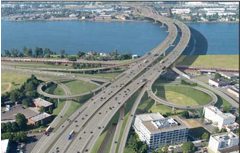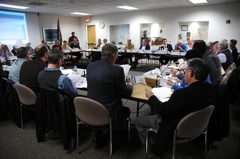
(Graphic: CRC)
Portland City Council has added their voice to the list of agencies and organizations that want the replacement bridge and light rail option to receive further study in the $4.2 billion Columbia River Crossing project.
Their unanimous support comes in the form of a letter to the Co-Chairs of the CRC Task Force, who are set to vote on their choice for a “locally preferred alternative” (LPA) tonight in Vancouver.
“The project will have an impact on our city for generations to come.”
–Portland City Council
Much like Metro’s vote and resolutions a few weeks ago, the Council’s letter does not establish how they will ultimately vote on the project (that happens on July 9th). Rather, it is meant to provide direction to Commissioner Sam Adams who is Council’s representative on the 39-member CRC Task Force.
At tonight’s meeting, the Task Force will vote on which single bridge option should move forward for more detailed study. The key decisions to be made are to do nothing, build a replacement or supplemental bridge, decide which kind of transit it should have (bus or rail), and figure out where the terminus of that transit should be.
It is widely assumed the Task Force will vote for a replacement bridge with light rail. The actual design of the bridge (including number of lanes, size and design of bike facility, and details of transit service) will not be set in stone until later in the process.

(Photos © J. Maus)
Portland City Council is one of six regional bodies who have veto power on the the CRC project and critics of the project consider them their best chance at a “no” vote.
The letter from Council — coming prior to hearing public testimony on the issue — has sparked concern from some.
Transportation activist and former City Council candidate Chris Smith posted a story about Council’s letter on his PortlandTransport blog with the headline, Council Drinks CRC Kool-Aid without Benefit of Hearing.
Jill Fugilister with the Coalition for a Livable Future was quoted in the Oregonian today as saying, “What’s the point of a hearing?”
But Shoshanah Oppenheim, transportation policy analyst for Commissioner Sam Adams, told me this morning that the letter “underscores the city’s concerns” with the project. She said, “We feel this was a very clear and concise way to direct Commissioner Adams and to advise the Task Force about what Portland’s concerns are.”

Mayor Royce Pollard at a Task
Force meeting in February 2007.
Oppenheim called Council’s letter a “distillation” of advice they’ve received from both the Portland Planning Commission and the Sustainable Development Commission. Both of those advisory bodies made their recommendations after receiving input during public hearings.
Included in the memo to the Task Force Co-Chairs are four pages of recommendations.
Among the recommendations listed under the heading of “Locally Preferred Alternative Recommendations”, the City writes, “Further technical analysis and public involvement is needed to determine the “appropriately sized” bridge for all multi-modal components,” and that the project should, “contribute to a reduction of vehicle miles traveled (VMT) per capita in the bi-state metropolitan area.”
Also included are a list of five recommendations for the pedestrian and bicycle facilities:
“A multi-use facility should provide for three separated facilities and space dedicated for southbound bicycle travel, northbound bicycle travel, and pedestrians adjacent to the high-capacity transit facility. This facility should meet or exceed standards set by ‘World class’ facilities.
Bicycle and pedestrian facilities on the river crossing bridges should provide for occasional rest areas and look out points.
The multi-use facility on the river crossing should be of continuous design and connect to the Hayden Island transit station and the EXPO station.
An urban standard pedestrian facility shall be provided on the east side of the Portland Harbor bridge connecting Bridgeton to Hayden Island.
Implement the pedestrian and bicycle improvements identified for the recommendations for the Hayden Island and Marine Drive interchanges.”
Oppenheim says Portland City Council wants to make sure they have an opening to influence various aspects of the project. “There’s no reason to think that a bridge of inappropriate size would be built without approval from City Council. What we’re trying to do at this point is to insert into the LPA more opportunities for oversight in the upcoming design process.”
_______
— Download the City Council’s letter and list of recommendations (232K PDF).
— For more coverage, see the Columbia River Crossing archives.

